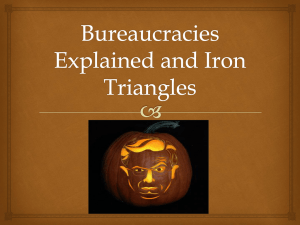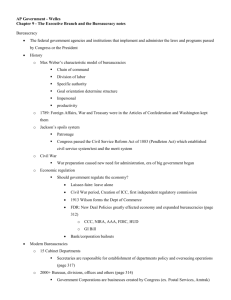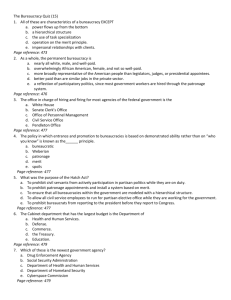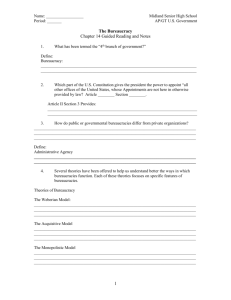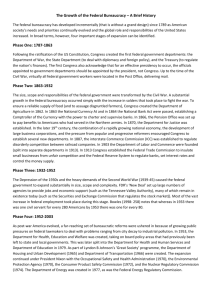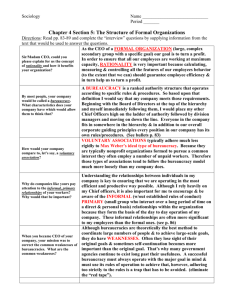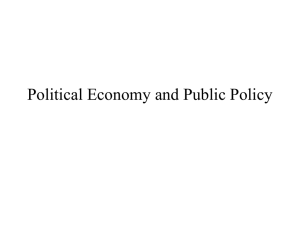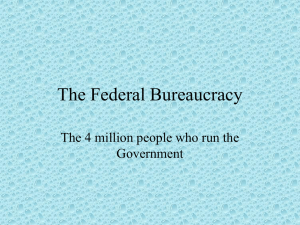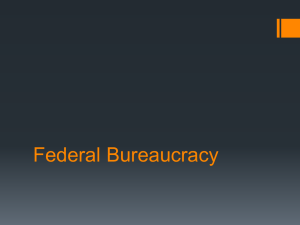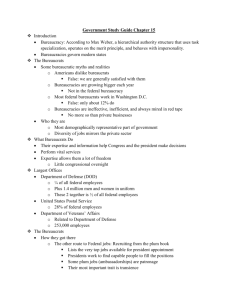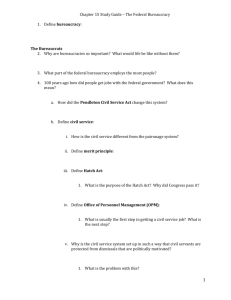History of the Bureaucracy
advertisement
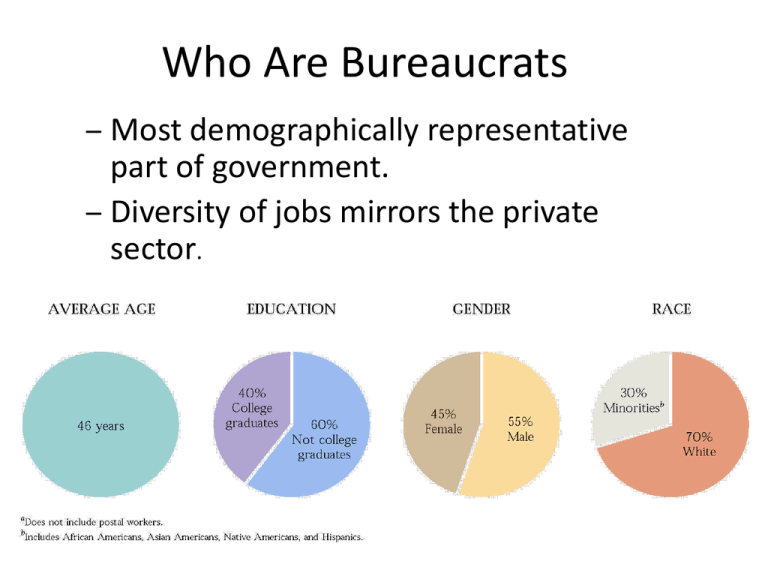
Who Are Bureaucrats – Most demographically representative part of government. – Diversity of jobs mirrors the private sector. 4 million employees; 2.8 million are civilians or “civil servants” President only appoints 3% (patronage or political appointments) 15 cabinet level departments 200+ independent agencies with 2,000+ bureaus, divisions, branches, etc. Biggest - Dept. of Defense, U.S. Postal Service, Veterans Administration Functions Implementation - carry out laws of Congress, executive orders of the President Administration - routine administrative work; provide services (ex: SSA sends social security checks to beneficiaries) Regulation - issue rules and regulations that impact the public (ex: EPA sets clean air standards) Federal Bureaucracy President Executive Office of the President (Ex: OMB, NSC) Cabinet Departments (Ex: State, Defense) Congress Independent Executive Agencies (Ex: CIA, NASA) Government Corporations (Ex: Amtrack, Postal Service) Independent Regulatory Commissions (Ex: FCC, SEC) Organization of Homeland Security Agencies after 9/11 Independent Executive Agencies • Established by Congress with separate status outside the executive branch • Given a specific mandate and generally perform a service function, not a regulatory one. • Some examples include: Social Security Administration, CIA, NASA, EPA. The Central Intelligence Agency (CIA) The Commodity Futures Trading Commission (CFTC) The Environmental Protection Agency (EPA) The Federal Communications Commission (FCC) The Federal Election Commission (FEC) The Federal Energy Regulatory Commission (FERC) The Federal Maritime Commission (FMC) The Board of Governors of the Federal Reserve System The Federal Retirement Thrift Investment Board (FRTIB) The Federal Trade Commission (FTC) The General Services Administration (GSA) The International Trade Commission (ITC) The National Aeronautics and Space Administration (NASA) The National Archives and Records Administration (NARA) The National Labor Relations Board (NLRB) The National Transportation Safety Board (NTSB) The Nuclear Regulatory Commission (NRC) The National Science Foundation (NSF) The Securities and Exchange Commission (SEC) The Postal Regulatory Commission (PRC) The Selective Service System (SSS) The Small Business Administration (SBA) The Social Security Administration (SSA) The Surface Transportation Board (STB) The United States Postal Service Independent Regulatory Commissions • IRCs exist to regulate a specific economic activity or interest such as the Federal Communications Commission (public air waves) or Federal Reserve Board (banking system, money supply) • IRCs operate independently from Congress and the President • Once appointed and seated, members cannot be removed without cause Government Corporations • Government owned businesses created by Congress • May or may not be profitable, but serve a public need • Ex: U.S. Postal Service, Amtrak, Tennessee Valley Authority, Corporation for Public Broadcasting – Civil Service: From Patronage to Protection. Patronage: Job given for political reasons. Civil Service: System of hiring and promotion based on merit and nonpartisanship. Merit Principle: Entrance exams and promotion ratings to find people with talent and skill. Office of Personnel Management: The federal office in charge of most of the government’s hiring. • History of the Bureaucracy – The Whig Theory (1780s – 1828) • The idea that public service was domain of an elite class. • Families had a tradition of public service. – The Spoils System (1828 – 1883) • Andrew Jackson used government jobs or “patronage” to reward supporters and to remove elitists from the bureaucracy • History of the Bureaucracy – The Civil Service System (1883 – Present) • Garfield’s Assassination 1881 • The Pendleton Act (Civil Service Reform Act of 1883) established the principle of employment on the basis of merit and created the Civil Service System to oversee the hiring and firing of government employees The Other Route to Federal Jobs: Recruiting from the Plum Book • Published by Congress. • Lists the very top jobs available for Presidential appointment. • Presidents work to find capable people to fill the positions. • Some plum jobs (ambassadorships) are patronage. Every four years, just after the Presidential election, the United States Government Policy and Supporting Positions, commonly known as the Plum Book, is published, alternately, by the Senate and the House. The Plum Book is used to identify presidentially appointed positions within the Federal Government. The Weberian Model of Bureauracracy Hierarchical authority structure Uses task specialization Operate on the merit principle Behave with impersonality A well-organized machine with lots of working parts. MAX WEBER German Sociologist Organization of Bureaucracies The Cabinet Departments --14 Cabinet departments headed by a secretary --Department of Justice headed by Attorney General --Each has its own budget, staff and policy areas --Republicans have been trying to eliminate several departments The President Supervises the Bureaucracy The President can: • appoint & remove agency heads • reorganize the bureaucracy • issue executive orders President Bush speaks about his budget priorities for FY 2007 • reduce an agency's budget Congress Oversees the Bureaucracy Congress can: • create or abolish agencies and departments • cut or reduce funding • investigate agency activities • hold committee hearings • pass legislation that alters an agency's functions • influence or even fail to confirm presidential appointments Federal Courts Check the Bureaucracy Federal courts can: • through judicial review courts rule on whether the bureaucracy has acted within the law and the U.S. Constitution • provide due process for individuals affected by a bureaucratic action Supreme Court of the United States Understanding Bureaucracies • Bureaucracy and Democracy Iron Triangles and Issue Networks – A mutually dependent relationship between bureaucratic agencies, interest groups, and congressional committees or subcommittees. – Exist independently of each other. – They are tough, but not impossible, to get rid of. – Some argue they are being replaced by wider issue networks that focus on more policies. the Iron Triangle is a term used to describe the policy-making relationship among; the congressional committees, the bureaucracy, and interest groups. Figure 15.5 • Bad Things That Bureaucrats Do… – Bureaucracies will try to expand authority – Bureaucracies will try to develop political constituencies – Bureaucracies will fight over jurisdiction – The “spend it or lose it” mentality – Bureaucracies will expand their internal work – Bureaucracies will become paternalistic and aloof – “The Peter Principle” – incompetence always rises to the top… – Who’s to blame when there’s a problem?
